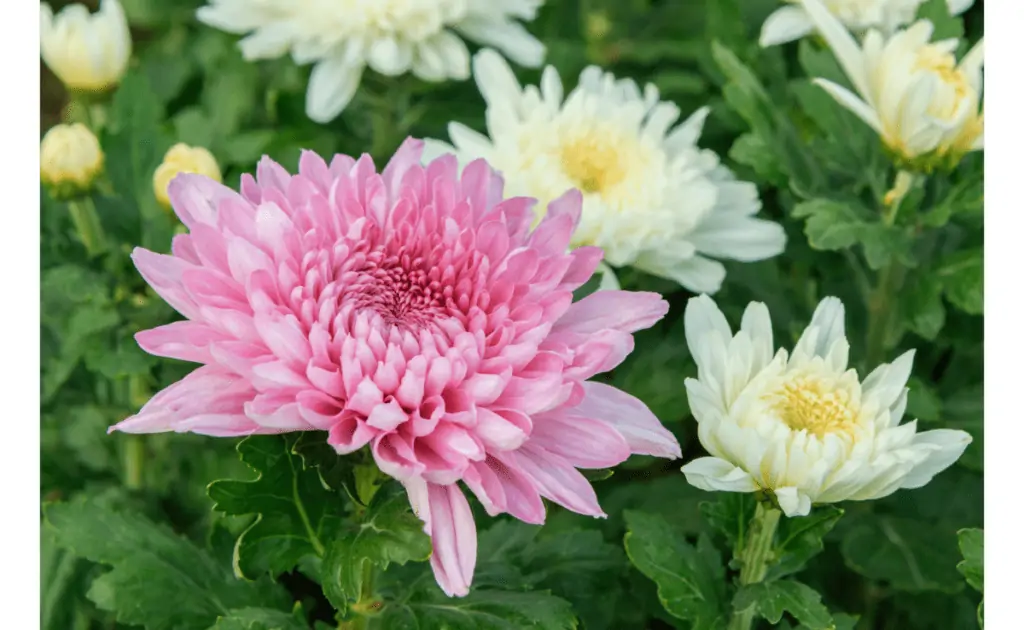
Annual flowers are known for their rich, vibrant colors and their ability to stand bright and bold all season. Placing annual flowers eloquently around your garden will add a glowing contrast to the other plants in your garden.
An annual flower is a plant that typically completes its whole growing cycle in one season. They grow once per year hence the name annual, but their seeds can grow a large yield throughout the season. They will stay in full bloom the whole season with continuous colors, making them a great bang for your buck. Since they only grow once a year you have to replant them every year.
There are annuals for any season given the particular climate of your area.
There are warm-weather annuals such as:
- Petunias
- Geraniums
- Marigolds – also great for vegetable gardens to keep away insects.
- Zinnias
And there are cool-weather annuals such as:
- Pansies
- Gerbera Daisies
- Dianthus
These annuals all have long periods of flowering and stay beautiful and in bloom for a long time.
The lifecycle of annuals determine when and how often you plant them:
- Seed
- Seed germination
- Mature plant
- Then the plant will flower upon maturity
- The flowers will then produce seeds
Once the seeds have been produced the plant will die. The seeds will stay in the ground until the time is right for germination again, usually next season. The life cycle of an annual is limited, but it can be extended through pruning, green housing, and depending upon your climate you might be able to extend the life in warmer climates. Check out our article on greenhouses here for more information.
Can I Plant Annual Flower Bulbs Mid-Summer?
Many people want to plant bulbs during the summer after seeing all the other beautiful flowers blooming around their neighborhood. Most warm annuals will need to be planted in early spring to be ready for summer. Others need to be planted in late fall in order to bloom in the spring.
The bulbs that you plant in the fall need a cold period to mature then bloom the next year, and there are warm-season bulbs that have to be planted after the ground gets warm.
Some half-hardy annuals such as Cosmos Rubenza can be planted mid-summer because they handle cold weather exceptionally well and will bloom in the fall.
What’s the Difference Between Annuals and Perennials?
The lifecycle and the way that perennials grow are very different than annuals. It’s a good idea to understand what the differences are so you know what position and where to place them in your garden.
Most plants are perennials including Mandevillas, most daisies, and Pentas. Perennials are flowers that have a lifecycle of more than 2 years. The main difference is that the annual will die after one life cycle.
A perennial will seed, germinate, produce a mature flower, produce more seed, but it doesn’t die at the end. The cycle will continue over and over for years.
If you want a massive display of annuals for an extended period of time then you will have to plant them again every time they reach their life cycle. If you plant perennials you will still get nice flowers just not as big and colorful as annuals but they will last longer if you care for the plant accordingly. Learn more about perennials in our Best Perennial Flower Seeds for Summer post.
It’s a good idea to have a mixture of both in your garden.
What’s the Easiest Annual Flower to Grow?
Some annuals are cut and come again flowers which means you can cut them one time and they give you more blooms throughout the season. The more you cut them the more they will produce. Some annuals are single bloom which means that you cut them once and you might get another bloom, but that’s it.
Many sunflowers are pro-cut which means they produce one flower per stem. After you cut it it’s done. The best way to keep these looking nice is to plant them in succession planting by planting in rows. This can be difficult to start off with for a beginner.
The easiest annuals to grow are Zinnias. They are good for a beginner to start growing from seed to plant. These annuals are very resilient to the weather, they produce lots of beautiful flowers that bloom again and again throughout the season.
These are cut and come again type of flowers, you just plant them once in May or when it starts to get warm in your area. The main thing is that you want to prevent frost so don’t plant them too early.
But when you get them in the ground you can enjoy them for the rest of the season. Some are short and some can grow up to 3 feet tall, it really depends on where and why you want to grow them. Maybe you want long stems so you can cut them and get more flowers, or maybe you want some short ones for your flower bed.
There are many different colors and types of zinnias to choose from:
Zinderlla Peach
These zinnias get about 24-30″ tall, take about 75-90 days to mature in the sun and they are really pretty they look like double echinacea.
Light Apricot Melon
The pedals downturn to make a cute shape and the tops are fluffy. They are good for arrangements with other contrasting colored plants because they stand out very well. These get about 2 1/2 inches wide and have very strong stems to keep them from falling over
Zinderlla Lilac
These lilac/pink flowers are a great addition to any garden that needs a little pink in it. They are very beautiful, they get about 25-30″ tall and they take about 75-90 days to mature like the other zinnias.
Queen Lime Blush
This zinnia has a pink/lime glow to it that will light up any garden. They make a symmetrical 3 1/2 inch diameter that is kind of hypnotizing to look into.
Queen Lime Orange
These bold orange flowers have a lime accent that mother nature herself would be proud of. These are the best annual flowers for the sun because they reach up to 40″ tall to soak up as much sun as possible. They are a great color to blend with your garden when transitioning from summer to fall.
Benary’s Giant Salmon Rose
The giant salmon rose are massive plants that are the best annuals to put in a large pot due to their size and presence. They have a bold salmon color and they can get up to 36″ high and the flowers can get up to 6″ in diameter.
You know your zinnias are ready to cut if you grab the stem about 8 inches from the ground and shake it if it’s sturdy it’s ready to cut. If there’s any flexibility when you shake it’s not ready yet. Wait until the stem is straight and stiff. When you cut it make sure you use a floral preservative and it should be able to live in a vase for 7-10 days.
What Are Some Good Annuals for the Shade?
When you’re planting your annuals you want something that can be put directly in your garden or in a pot on your porch. You want something that will take morning sun/afternoon shade, dappled shade, or in an area that is in the shade all the time.
Caladiums
Caladiums come in lots of different colors and they do well in places that might get a little sun here and there.
Hypoestes aka Polka dot Plant
These plants do well in the home, in a terrarium, and in gardens outside. They will not last the winter, but you can replant them in a pot and bring it inside.
Crossandra
This is a stunning plant with a bold orange color and shiny leaves that blooms continuously throughout the summer in the shade. These are the best annuals to put in a shady flower box, or in a pot if you want them to grow tall.
Begonias
They come in pink, white, dark red, or canary with green leaves, and they love the shade.
Torenia
Torenias can take quite a bit of sun, but prefers the shade, they get about 8 inches tall and 8 inches wide. They have rich purple colors blooming constantly all season.
What is a Half-Hardy Annual?
Some annuals can handle cold weather better than others, but they also take longer to grow than others. They like cool weather better than other annuals so you should plant them indoors, then in a month or 2 take them outside and put them in your garden.
They require a cold dormancy period to germinate called stratification.
Bells of Ireland
These glowingly green annuals are tolerant of cold and light frost. You should plant them as soon as your soil is ready so they have the best chance to enter the stratification process. They need to build a taproot so they don’t get transplant shock when you take it outside.
Celendula aka Pot Marigold
These pretty little flowers can also be used as a salad topping which makes them good for the kitchen garden. They’re the best annuals to grow in the early spring and late fall when it’s still cool out. They have a bright vibrant orange color and they’ll give you lots of flowers when it matures.
Cosmos Purity
The Cosmos Purity is going to produce lots of flowers as well. They are simple white pretty flowers that will look nice in your garden when they bloom in the spring.
Cosmos Rubenza
The rubenzas have a dark rich color and they are the best annuals to border your flower beds because they get about 27″ tall. They look great ever after a week in a vase as well. You’ll want to plant these at the end of July or the beginning of October.
Nicotiana Alata Grandiflora
These do great in both the shade and cool weather. They don’t like heat or sun at all they will fall right over. When the temperature is cool it blossoms fully and lets out a spicy fragrance similar to jasmine. You can put it in a vase and put it near your bed for some aromatherapy.
Can an Annual Flower Live Forever in a Greenhouse?
Some annuals can be saved to replant in your garden next year. Not all annuals handle the winter well, even if you bring them inside. Many annuals such as geranium, euphorbial canna lilies, and dahlias may survive if you keep a close eye on them. They can do well if you take them out of your garden and put them in the house for the winter through the process of overwintering.
There are also ways that you can extend the life of your annuals by emulating their preferred weather conditions. By using a greenhouse you can control the climate that your plant lives in and prolong its life. Annuals can survive a blizzard if they are in a well-lit, well-heated greenhouse and they are given proper care. If you can replicate their outdoor climate they’ll do fine.
As long as the conditions that are required for them to survive are right, an annual can live forever in a greenhouse.
Annuals are extremely beautiful flowers that will be a show stopper for any garden. Arranging your own unique color palette with the placement of your flowers is an art that will be the hallmark of your garden.
When grown in the right conditions they will continue to take your breath away season after season.

This post contains affiliate links. If you make a purchase through these links, we may receive compensation at no additional cost to you.
